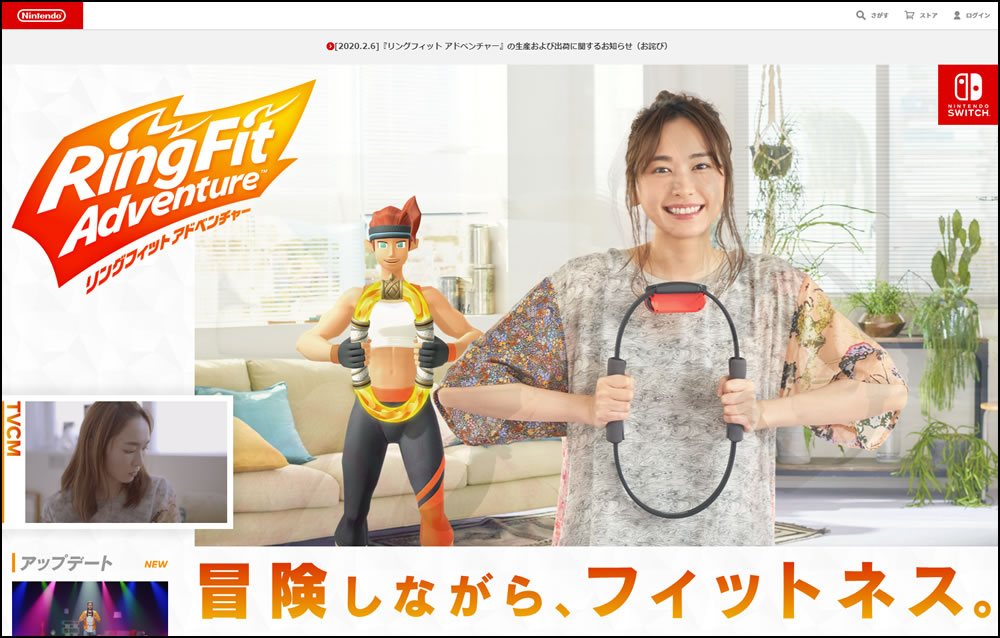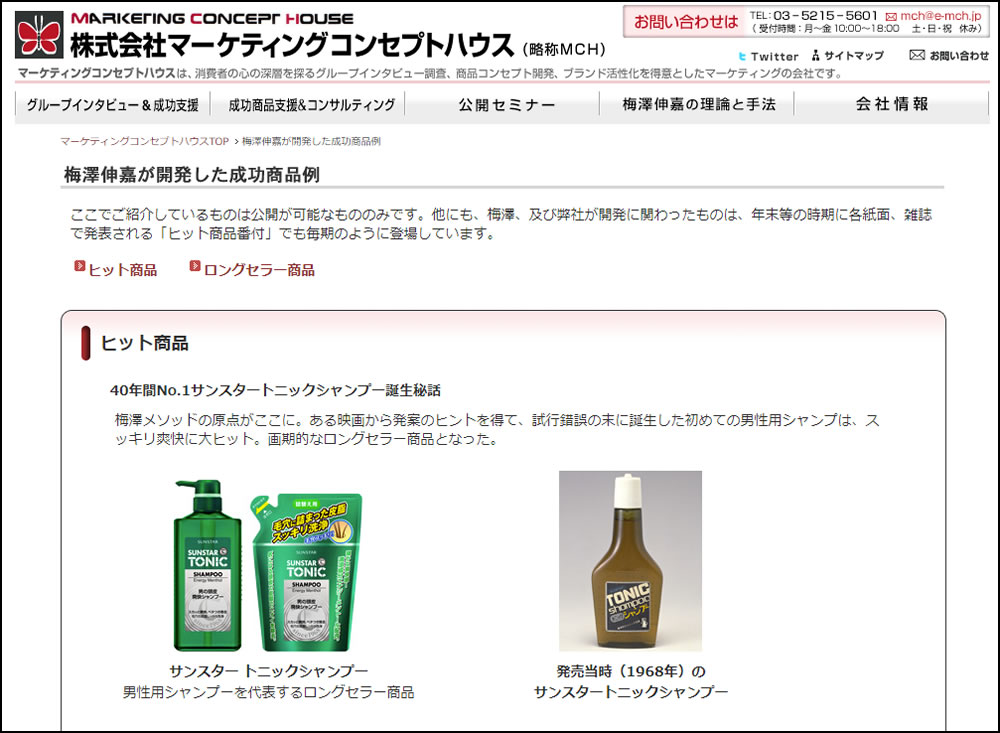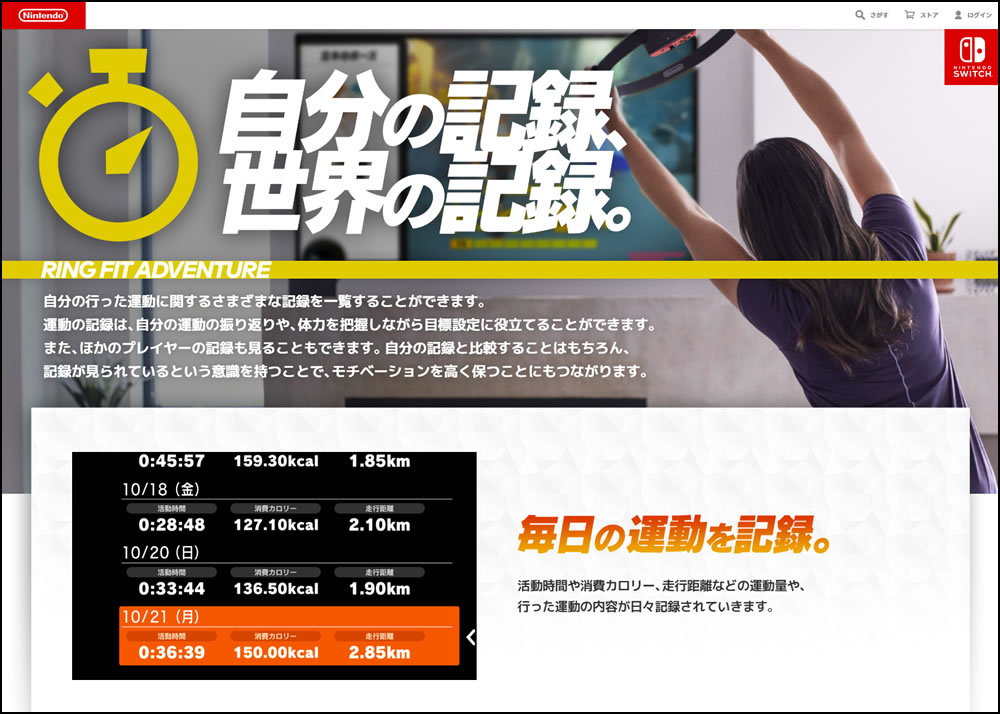The novel coronavirus has been spreading around the world. Amid this situation, Ring Fit Adventure, an action role-playing video game released in October 2019, has been in short supply. The rapid change in the relationship between video games and society has led to an unexpected shift in the sales of this product.
 A capture from official Nintendo website.
A capture from official Nintendo website.
About the formula for creating a hit product
UMEZAWA Nobuyoshi, known for such hit products as “Sunstar Tonic Shampoo,” “Kabi (mold) Killer,” and “Tempuru” (a tempura oil treatment agent), has proposed the “unmet needs theory” for product development (*1). “When a product meets a ‘strong unmet need,’ consumers feel that they ‘want’ the product.” In the case of Tempuru, “If you want to cook tempura at home, but it’s too much trouble to dispose of the used oil, then make a product that can be solidified and burned, and it will be a hit.”
The point is to create “unlikely” products and create new markets. To do so, it is important to carefully observe consumers, which leads to uncovering “insights” in advertising terms. The same is true for game development. NAKAMURA Takayuki, formerly of Namco and now an associate professor at Kanagawa Institute of Technology, who served as producer of Kotoba no Puzzle: Mojipittan (AC version released in 2001), highly evaluated that theory. “I really learned from Mr. UMEZAWA’s theories, and I was able to put them into practice and connect them to actual results,” he wrote in his blog (*2).
 An image capture of Marketing Concept House’s official website. UMEZAWA Nobuyoshi serves as its president.
An image capture of Marketing Concept House’s official website. UMEZAWA Nobuyoshi serves as its president.
The impact of the spread of the novel coronavirus
Sometimes, rapid changes in living conditions reinforce the “unmet need” that consumers have for a product that has already been launched. Nintendo’s Ring Fit Adventure , an experiential fitness game released in October 2019 for the Nintendo Switch, is such a case. The product had a relatively quiet start in the first week of its domestic release of 66,952 units (*3) but continued to sell consistently without dropping from the top ten sales ranking, with sales of 706,945 units as of March 29, 2020. The global pandemic seems to have affected the product’s sales. Looking at the chart of weekly unit sales, a third surge can be seen immediately following “immediately after the launch” and “year-end sales.” It was predicted from the beginning that the product would sell reasonably well during the year-end sales. Given the nature of playing in front of the TV, demand for relief from weight gained during the New Year’s period was expected. However, few people could expect sales to pick up again soon after that.
 Created by the author based on the data published on the Dengeki Online website
Created by the author based on the data published on the Dengeki Online website
In fact, January 13 to 19, when sales increased 1.65 times from 19,235 to 31,788, corresponds to the period when cases of the novel coronavirus began to spread in the country. The following week, on January 23, the city of Wuhan, China, was shut down, and in the week after that, on January 27, Japan’s Ministry of Health, Labour and Welfare announced its intention to designate the novel coronavirus as an infectious disease. On February 3, the Diamond Princess entered the port of Yokohama, and on February 13, the first death in Japan occurred. Perhaps some users reacted sensitively to this series of circumstances.
Not a few people involved find the current numbers frustrating. This is because there has been an ongoing shortage since the end of the year, and some units have been sold at a premium. In fact, at the time of this writing (April 7, 2020), units with a list price of 7,980 yen (excluding tax) are being sold online for around 20,000 yen. This is because the spread of the novel coronavirus is disrupting China’s production and distribution systems for Nintendo Switchrelated products. Nintendo also issued a press release on February 6, apologizing for this matter (*4).
In other words, while the product power of Ring Fit Adventure remained intact, the social side of the equation was rapidly changing, which meant that people were not able to fully exercise and play outdoors. There was a growing need for a solution to this at home, and many users jumped at the opportunity. This need was further heightened when temporary school closures were requested for elementary and junior-high and high schools, as well as special support schools across the country on February 27. Even so, a shortage of the products remains. It seems the people involved are deeply ashamed, as it’s not hard to imagine that a significant opportunity loss has been created.
These conditions are ongoing on a global scale. WIRED online news reports how users in the United States scoured the inventory to buy the product (*5). In China, significant volumes of the product have been resold via online shopping sites, even though the official release had not taken place. An Australian chain of specialty game stores has restricted sales to no more than two units per person. According to research site VGChartz, worldwide sales had reached 2.17 million units as of December 31, 2019, and it will be interesting to see by how much the number will increase in the future (*6).
Integration of social games with console games
So, what kind of game is Ring Fit Adventure, which is attracting so much attention from all over the world? Let’s examine the product’s content below.
This is a new type of game. The player holds a device on a ring, the Ring-con, in both hands and wraps a “leg band” around their left thigh before proceeding through an action game or RPG-like adventure. The Joy-Con (R), an exclusive controller for the Nintendo Switch, is attached to the Ring-con and the Joy-Con (L) to the leg band. The player’s physical condition is monitored by various sensors on the Joy-Con, and the player’s body movements are linked to a character displayed on the TV.
In the main adventure mode, the hero, together with “Ring,” a ring-shaped character, will explore various courses in order to stop the ambitions of the demon “Drago,” who is trying to envelop the world in darkness.
The game is divided into two parts. In one, the player moves through a field. In the other, the player engages in combat with the enemy. In the former part, the player jogs lightly as if stamping their feet (*7), and the main character runs on the field on the screen. In the latter, the player launches a “fit skill” that is activated by striking a specific pose and attacks the enemy, just like a turn-based RPG. To activate the fit skill, a variety of exercises is required, such as pushing and pulling on the Ring-con, or sitting in place and extending and contracting the legs.
As you complete a stage, the hero gains exercise points based on the amount of physical activity in both parts of the game, increasing the hero’s offensive and defensive abilities, learning new fit skills, and so on. There are also other rhythm games and a jogging mode where you can enjoy the rhythm game and go through the course in the game.
Also, the motions of pushing and pulling on the ring-controller are required for basic operations such as advancing and returning to the game (normal controller operations can be substituted) and are designed to lead to natural exercise.
The features of the product are not limited to these “easy to play and understand” parts. The game’s foundation, the “build-out” part, is also very well done. The game’s intuitive controls allow you to progress without reading the manual, and the gradual difficulty design makes the game progressively more complex as you play. In order to get the player’s motivation going, the game design know-how is also applied to the fact that the “ring” is praised incessantly while playing. It is the culmination of Nintendo’s careful game making.
Thus, the game is packed with plenty of elements that give players the chance to exercise so they overcome their inactivity. This is a product that enriches the player with entertainment in the same vein as Brain Age: Train Your Brain in Minutes a Day! (2005), which was supervised by KAWASHIMA Ryuta, professor of New Industry Creation Hatchery Center, Tohoku University, and Wii Fit (2007). Both were released by Nintendo and became huge hits at the time. It is also positioned as a product in a serious game context, solving social problems through gaming.
However, there are some important elements missing from this product that Brain Age and Wii Fit had. There are the parameters that describe a player’s status in a nutshell, such as “brain age” and “weight.” The product also has the ability to list past accumulated exercises, but it’s hard to see at a glance what state you are in as a result. To compensate for this, the product adds new narrative elements and “levels” as a visual indicator of the hero’s status.
The product’s storyline is not radical nor does it entice the player to find out what happens next. On the contrary, if you focus on the story elements, you might contradict the product’s concept. That is because in trying to know what’s going on with the story, you may end up physically damaging your body in the heat of the game. That would defeat the purpose of the plan. On the other hand, if the content were not so interesting, it would be difficult to get people to play it every day. Therefore, the product requires an interactive design, as with a social game.
 A capture from official Nintendo website
A capture from official Nintendo website
In fact, the game also has a feature that allows you to compare play time, exercise content, and progress in the adventure mode online. These are standard mechanisms in social games. However, to use these features, you are required to subscribe to “Nintendo Switch Online,” a paid service. Also, all you can do online is “look at the record” and there are no mechanisms that encourage you to interact with each other. So what should you do to have fun with this product? In this regard, it seems that the development team has not been able to provide an answer on this point.
Another factor that may hinder the spread of the product, ironically, may be the presence of Wii Fit. I may guess that some people bought Wii Fit during the boom, but didn’t succeed in losing weight and the special controller, “Wii Balance Board,” also gathered dust. Such families exist. While a game experience with a dedicated controller, such as this one, can easily attract attention, it can also be a transient one. Nintendo will also need to propose new uses for the game’s Ring-con and leg band.
There are some interesting measures in this work. There is a free update that provides content. The aforementioned “rhythm game” and “jogging” were both added in a March 26 update. In addition, the “custom” function, which allows you to create your own fitness list, was enhanced. A free update about five months after its launch in October is a rarity, and we can expect to see more of it in the future. In the process of the gradual elimination of the scarcity of products, these measures are expected to stimulate and lead to further sales growth.
Ring Fit Adventure [Nintendo Direct mini 2020.3.26]
As indicated at the beginning of this article, the firm’s domestic sales are growing at the rate of 10,000 units a week. It is calculated it will take 30 months to reach one million units, the yardstick for a hit product. This is largely due to external factors such as the disruption of production and distribution systems in China due to the spread of the novel coronavirus. On the other hand, the pandemic has led to an increase in demand, which must be a mixed blessing for those involved. There are concerns about the infection’s medium- to long-term effects. I hope that the measures to maintain the life of products will be taken for this product as well.
(notes)
*1
Marketing Concept House Inc., UMEZAWA Nobuyoshi’s Theory and Methodology Unmet Needs Theory (The Theory and Methodology of UMEZAWA Nobuyoshi: Unmet Needs Theory)
http://www.e-mch.jp/theory/needs.html
*2
Blog of a former producer of Mojipittan, “There is a technique to produce a hit product.” May 2, 2011
http://pdblog.play-app-lab.com/?p=225
*3
Dengeki Online, “[Weekly Software Sales Ranking Top 50] Ring Fit Adventure sold 67,000 copies (October 14–20)” October 24, 2019
https://dengekionline.com/articles/15870/
*The following weekly sales figures are based on the site’s content.
*4
“Apology for the impact of novel coronavirus infections on production and shipments of Nintendo Switch and other devices” on Nintendo official site (February 6, 2020)
https://www.nintendo.co.jp/support/information/2020/0206_01.html
*5
WIRED, Coronavirus Fears Spark a Run on Nintendo’s Ring Fit Adventure (March 10, 2020)
https://wired.jp/2020/03/12/ring-fit-shortage-coronavirus-covid-19/
*6
VGChartz Ring Fit Adventure (NS)
https://www.vgchartz.com/game/225646/ring-fit-adventure/
*7
In silent mode, up and down movements of the upper body can also be substituted.
*URL links were confirmed on April 20, 2020.












